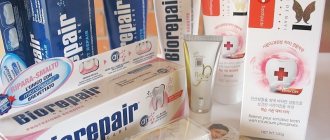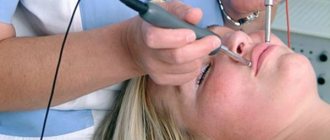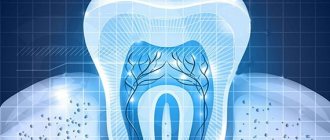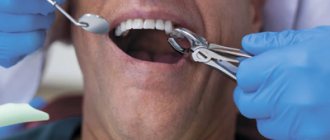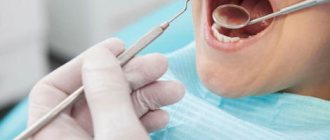Electrophoresis for osteochondrosis of the cervical spine is an effective method of treatment, characterized by a gentle effect. It is used in modern medicine quite often, which is associated with the absence of complications and side effects. Treatment of cervical osteochondrosis with electrophoresis in most cases avoids surgical intervention.
Electrophoresis for osteochondrosis of the cervical spine
What is the treatment procedure?
The main advantage of the electrotherapy method is painlessness and lack of discomfort, which distinguishes it from injections and swallowing tablets. Medicines, transformed into ions, enter the patient’s body through intact skin or mucous membranes under the influence of direct or pulsed current. The effectiveness of treatment is due to the simultaneous influence of two factors on the body: medication and current.
Electric current allows you to speed up metabolic processes in the human body. Administration of drugs through ionotherapy has a number of advantages over delivering them intramuscularly, intravenously or orally:
- creating a long-lasting effect from the administration of the drug due to accumulation in the subcutaneous fatty area and slow consumption;
- no side effects;
- painless delivery of the drug to the desired area of the body;
- no tissue damage during drug administration;
- reducing the dose of the drug.
From a physics point of view, the procedure is the process of decomposition of an electrolyte into ions when it interacts with water (dissolution) or under the influence of high temperatures (melting). In an aqueous solution, the drug breaks down into ions, which, under the influence of current, begin to move and enter the body through the mucous membranes and skin. Then the ions are evenly distributed in the cells and in the intercellular fluid.
The amount of drug absorbed from the solution during electrophoresis depends on many factors. Among them: the patient’s age, the condition of his skin, current density, the amount of substance in the solution, etc.
During the procedure, the patient will not feel discomfort or pain. Electrophoresis is prescribed to both adults and children, as it is absolutely harmless and effective for treating a number of diseases. Another positive point is that drugs administered under the influence of current do not penetrate deeply, but remain in the subcutaneous fat layer, so they have a longer lasting effect on the body.
Numerous studies have shown that the procedure increases the skin's sensitivity to medications, which increases their activity. Electrophoresis is also prescribed for infants. It is better to carry out the procedure at home, since there may be patients in medical institutions.
Benefits of electrophoresis for children
It is very important that transdermal administration of drugs allows one to reduce the current dose of medication, reducing side effects and preventing possible allergic reactions. For example, 5–10% solutions of substances are used to introduce local effects, and 1–2% solutions are used for segmental reflex effects. Electrophoresis allows for the most targeted administration of medicine to the affected area, without painful and frightening injections for children. Also, the effect of the drug is extended over time, reducing its one-time concentration in the blood. This also happens because a temporary “depot” of the drug is created in the skin, which gradually enters the blood. The medicine can remain highly concentrated in the skin for up to 21 days.
Among the various drug delivery systems available today, the transdermal drug delivery system has shown the best results in improving the quality of life of young patients due to the main advantage: avoiding first-pass metabolism of the drug through the liver, which would significantly reduce the effectiveness of the drug. Other clinical benefits include controlled delivery of drugs, maintaining stable plasma concentrations without pain. The stratum corneum, which is the outermost lipid layer of the skin, acts as a barrier to the absorption of highly polar and hydrophilic drugs. The penetration or absorption of such drugs can be improved using various penetration enhancers (dimexide) and physical and mechanical methods. Nowadays, electrophoresis and iontophoresis have become very useful techniques that transport charged drug molecules across biological membranes and tissues using a weak electrical current.
Indications for electrophoresis
The electrotherapy method is prescribed to newborns from 4 months of age, when there are indications for the procedure. For infants, procedures are necessary in the treatment of hip dysplasia and neurological pathologies. Electrophoresis allows you to deliver medicine to the child’s body without intravenous injections. Often, to increase the effect of treatment, electrophoresis is prescribed along with massage. Both procedures are absolutely painless and do not cause any discomfort to the baby.
Electrophoresis at home is more effective than in a medical institution, since the child does not receive stress. He does not need to be taken to a children's clinic, where there are many sick children. Devices for carrying out the procedure are freely available. Before purchasing equipment for electrophoresis, consult your doctor; he should prescribe special medications that can be used in ion therapy. Electrophoresis, like any treatment method, has contraindications. The local pediatrician must notify them. It is not recommended to perform endonasal electrophoresis at home, as this is a complex procedure that affects the nasal mucosa.
Indications for procedures
Electrophoresis is prescribed to all patients diagnosed with a hernia who experience severe pain - an inevitable companion to this disease. Other indications depend on the type of protrusion.
Each type of intervertebral hernia has serious complications, so you should not delay treatment.
See how easy it is to get rid of a hernia in 10 sessions
Indications for electrophoresis for cervical hernia
For herniated intervertebral discs in the cervical spine, electrophoresis is prescribed for:
- dizziness and migraines;
- surges in blood pressure;
- weakness in the upper limbs;
- loss of sensitivity in the limbs;
- limitation of movement, muscle weakness.
Read more about cervical hernia in this article.
Indications for electrophoresis for thoracic hernia
For a thoracic hernia, electrophoresis is indicated for anyone who has:
- numbness, tingling in the upper extremities;
- limited mobility due to muscle hypertonicity.
Read more about the symptoms and treatment of thoracic intervertebral hernia here.
Indications for electrophoresis for lumbar hernia
For a lumbar hernia, electrophoresis is prescribed if the following symptoms are present:
- tingling sensation, numbness of the lower extremities;
- problems with urination;
- the feeling that “your legs won’t obey you.”
Read about other symptoms in the article “Intervertebral hernia of the lumbar spine.”
Ion therapy is effective in treating a number of diseases:
Muscle hypertonicity in newborns . When performing electrophoresis, aminophylline is used. This drug increases blood circulation and promotes the growth of cartilage tissue.
Bronchitis . In case of illness, a procedure with calcium is prescribed. If there is a large amount of sputum, the patient is injected with calcium chloride using a current, and if there is a dry cough, calcium iodide is administered. Electrophoresis supplies the localized site of the disease with a drug that effectively fights the inflammatory process.
Pathologies of the joints and spine: arthrosis and osteochondrosis . The procedure is carried out using an anesthetic - novocaine. During the procedure, the main manipulations occur in the area where severe pain is localized. A gasket soaked in a 0.5% solution of novocaine hydrochloride is placed between the anode and the patient’s body. The standard course of treatment is at least 10 procedures. In case of severe pain, electrophoresis is prescribed 2 times a day for 15-25 minutes.
Skin diseases : melanoma, acne or furunculosis. In these cases, copper is used as a drug, as it has an anti-inflammatory and antitumor effect.
Keloid scars . Only scars at an early stage are treated with electrotherapy. To combat them, procedures with lidase are used. Sometimes this treatment is supplemented with electrophoresis with collagenase, since only with an integrated approach can the scar be reduced in volume or stop its growth.
Gynecological diseases associated with unsuccessful pregnancy. Treatments with zinc are prescribed. They are contraindicated on certain days of the monthly cycle, so they are not recommended without the approval of a gynecologist.
Intervertebral disc herniation . The disease is effectively treated with ionotherapy with Karipazim. This drug softens the hernia, so its effect on the nerve ending weakens and the pain goes away. The procedure will require two pads. Karipazim is applied to the first one and is connected to the positive pole of the device, and a heated 0.9% sodium chloride solution is applied to the second (it is connected to the negative pole of the equipment). The affected joint of the spine should be placed between the pads and current should be passed through it. Treatment of a herniated disc with electrophoresis is a long process. It will take 2-3 courses of 20-30 procedures every 1-2 months.
Increased uterine tone during pregnancy . The procedure is harmless for both the expectant mother and the baby. But if fears still creep in, then it is better to abandon electrophoresis during pregnancy and breastfeeding.
Pathologies of cardiovascular diseases . Calcium electrophoresis is performed.
With the help of electrophoresis, pathologies of the nervous, digestive, and genitourinary systems, sleep disorders, neuroses, migraines, burns, and a number of other diseases can be cured. Sometimes one drug is not enough to completely improve the patient.
Ion therapy cannot be used as an isolated method in the treatment of pathological processes in the body. It can be used as additional therapeutic procedures, for example: along with taking antibiotics. The dosage of drugs may vary. Children and the elderly are prescribed a reduced dose, which is one third lower than for the average person. Electrophoresis sessions should be carried out daily, perhaps every other day. The course of electrotherapy ranges from 10 to 30 procedures.
Despite the fact that there is no harm from electrophoresis, you should not self-medicate either. First you need to consult a doctor, namely, he should prescribe a drug or a set of drugs for electrophoresis.
Nasal electrophoresis with calcium
In the nasal area, electrophoresis is used to treat otolaryngological diseases, lung diseases, and dental pathologies. Electrophoresis acts locally and systemically, and its effect contributes to:
- reducing the inflammatory process;
- reducing swelling;
- accelerating regeneration processes;
- activation of the body's defense mechanisms.
Most often, electrophoresis with calcium in the nose is prescribed for:
- inflammation in the nasal cavity and sinuses (sinusitis, rhinitis, etc.);
- inflammation in the ears (otitis media);
- dental diseases (pulpitis, granulomas, etc.);
- lung diseases (bronchitis, pneumonia).
Before electrophoresis is carried out in the nose, the nasal sinuses are washed with water to free them from mucous masses and contamination. Next, special tampons are moistened with a calcium-containing preparation and placed into the nose to a depth of 1-2 cm. An electrode with two plates is placed in both nostrils, and the other in the area of the lower cervical vertebrae. During the procedure, the drug is well absorbed through the nasal mucosa and penetrates the nasal sinuses.
Contraindications to ion therapy
Electrophoresis has contraindications. Before you begin the procedures, you need to familiarize yourself with them. These include:
- pustular infections on the skin;
- malignant neoplasms;
- kidney disease;
- bronchial asthma;
- inflammatory processes in the acute stage;
- allergy to the drug that must be administered during electrophoresis;
- blood clotting disorder;
- intolerance of the body to electric current;
- heart or kidney failure, etc.
Electrophoresis with calcium: contraindications
Contraindications for the procedure include:
- increased sensitivity and individual intolerance to drugs containing calcium;
- electric shock intolerance;
- the presence of purulent foci of inflammation;
- damage to the skin;
- dermatitis;
- body temperature above subfebrile levels;
- oncological diseases;
- presence of a pacemaker;
- severe disruption of the cardiovascular system;
- severe impairment of the kidneys and liver;
- mental disorders.
What should you remember when performing electrophoresis at home?
Electrophoresis can be done at home only after consulting a doctor. Make sure you have no contraindications to the procedure. Otherwise you will treat one thing and “criple” the other. You can start ion therapy only after thoroughly studying the instructions, correctly installing the electrodes and preparing the necessary solutions in certain proportions and quantities. It is not recommended to do more procedures than the doctor prescribes, since the absorption of drugs may decrease.
Before the first procedure, get a prescription from your doctor with the dosage of the drug according to the course of treatment. It is advisable to invite a nurse to clearly demonstrate electrophoresis, and then repeat her actions.
Indications and contraindications
Electrophoresis is very similar to galvanization. Galvanization is different in that it applies direct current, but does not contain any medicine. Therefore, electrophoresis can also be called “medicinal galvanization.” Indications for electrophoresis will be:
- chronic inflammatory diseases of the musculoskeletal system (myositis, rheumatism, osteochondrosis and its complications);
- compression neurovascular syndromes;
- plexitis, neuritis and neuralgia;
- syndrome of acute pain in the neck (cervicago), chest and lower back - lumbago;
- chronic myofascial tonic syndrome, causing constant back pain.
Many of the above conditions are inevitable companions of discogenic exacerbations of osteochondrosis.
Electrophoresis is indicated in the initial stages of hypertension and coronary heart disease (with the exception of unstable angina). This method is used for pathologies of the lungs and bronchi, gastrointestinal tract, various gynecological and urological pathologies, diseases of the ENT organs and in many other cases.
General contraindications to electrophoresis include any tumor growth, both malignant and benign, active tuberculosis, suppuration, streptoderma, erysipelas at the sites where electrodes are applied and bleeding wounds, disorders of the integrity of the skin such as eczema and psoriasis, skin mycoses .
Special contraindications include intolerance to exposure to electric current, foreign metal prostheses in the intended area of influence, severe cardiovascular insufficiency, and heart rhythm disturbances.
Duration of electrophoresis procedures
The amount of ions introduced into the body is determined by the strength of the current, the area of the active electrode and the duration of the procedure. In children, depending on age, it can reach 20 minutes. In pediatrics, it is always preferable to increase the procedure time instead of increasing the current intensity to avoid discomfort in children. In any case, a slight reddening of the skin will be noted under the electrodes - due to local expansion of microvessels from irritation by acidic and alkaline electrolysis products.

